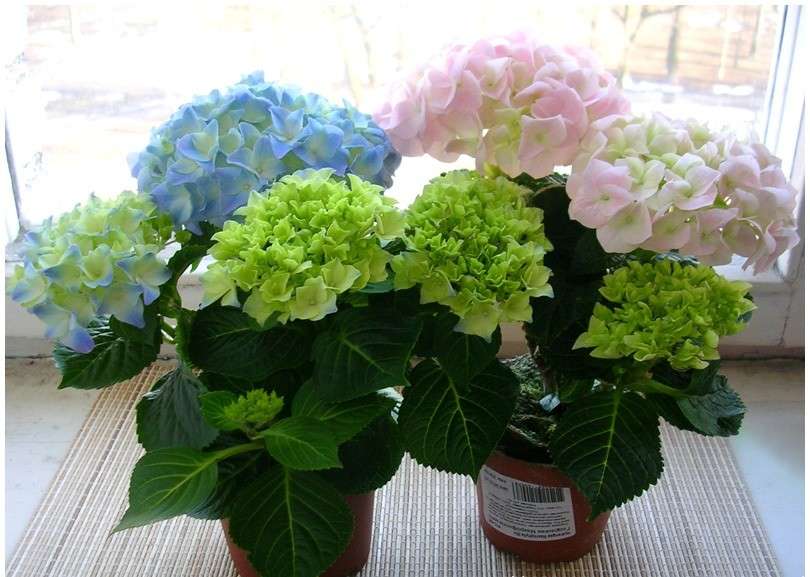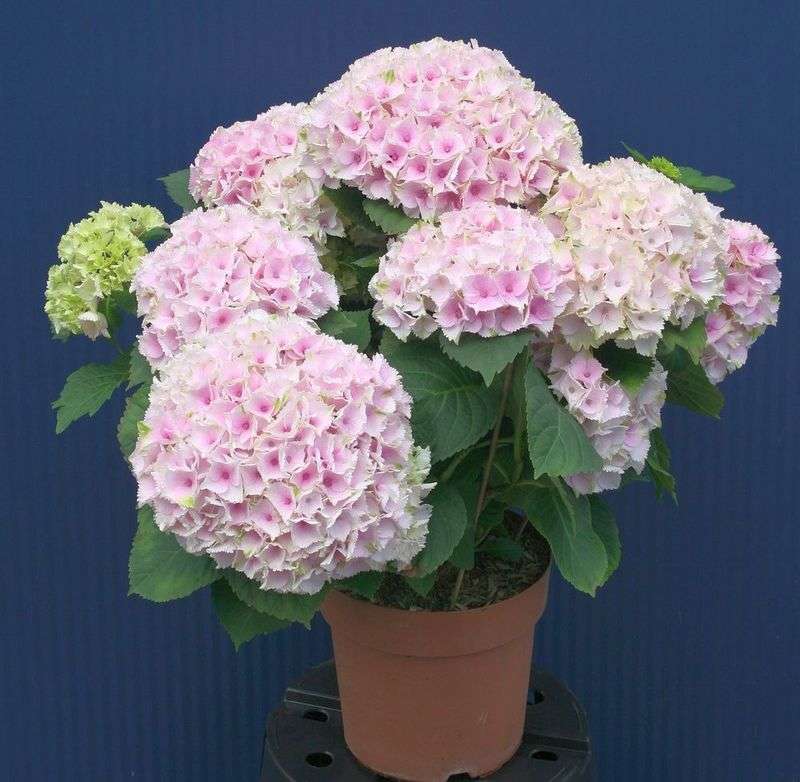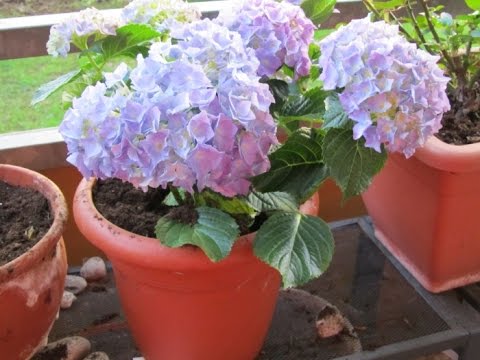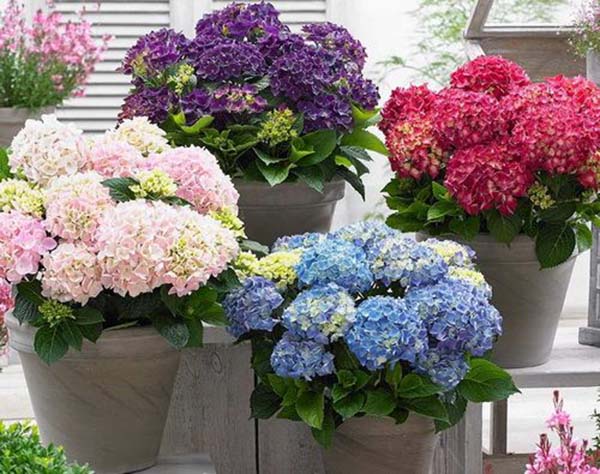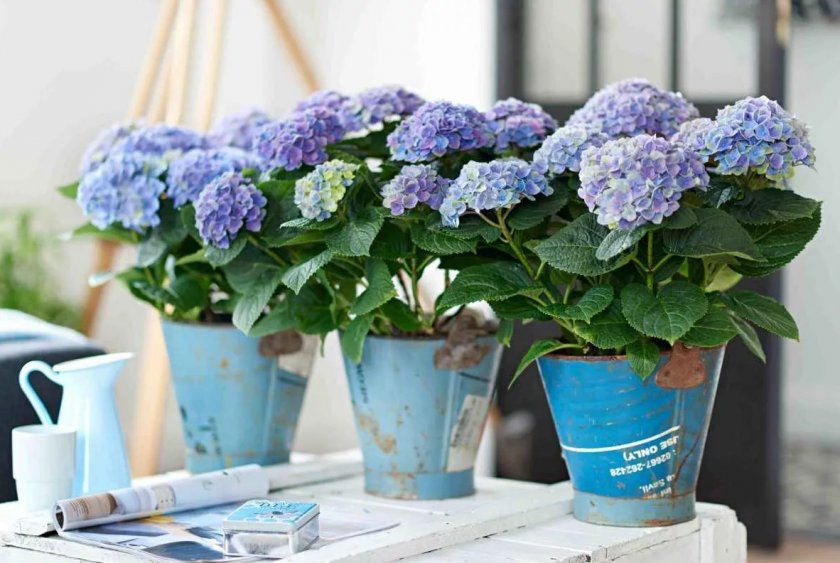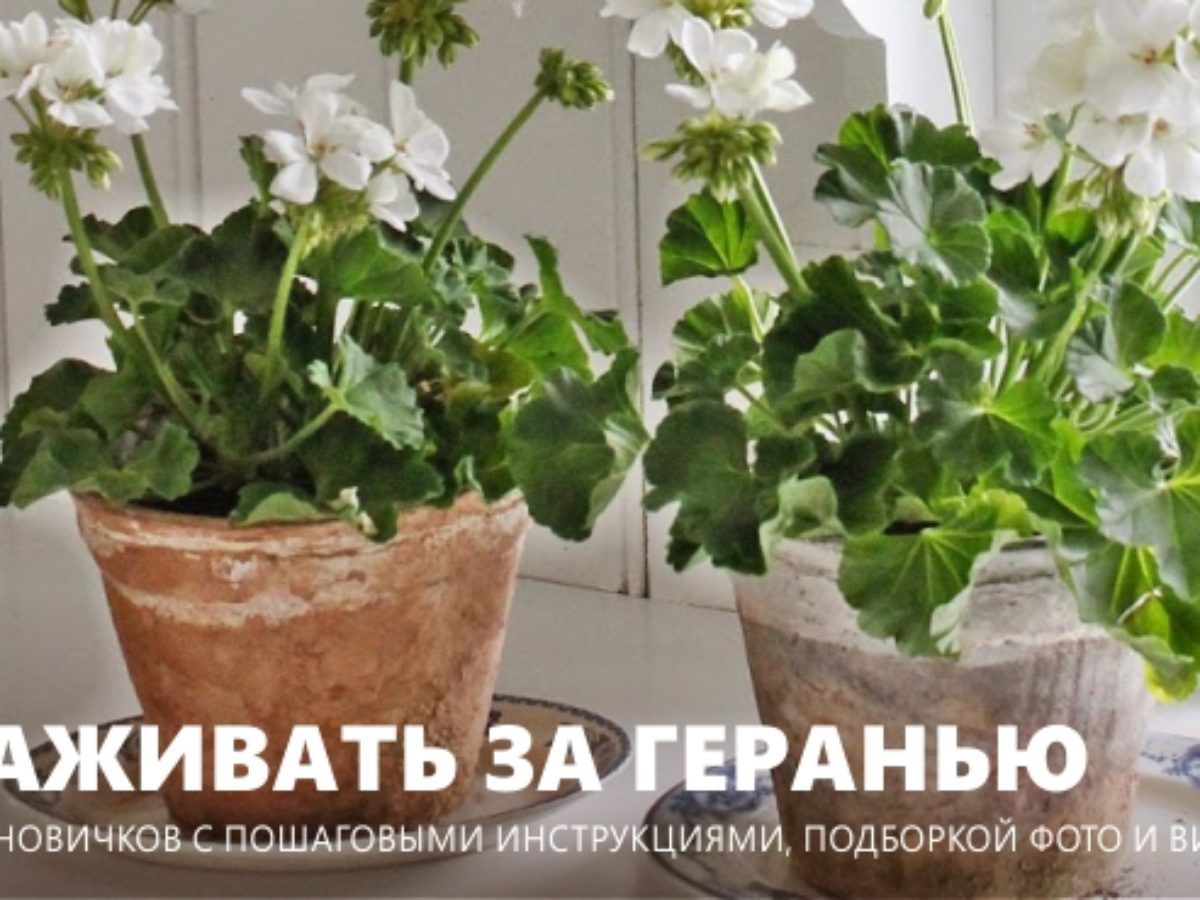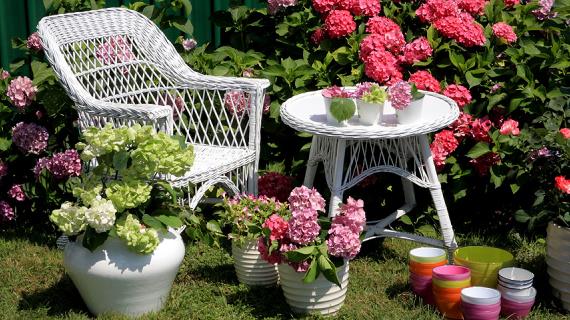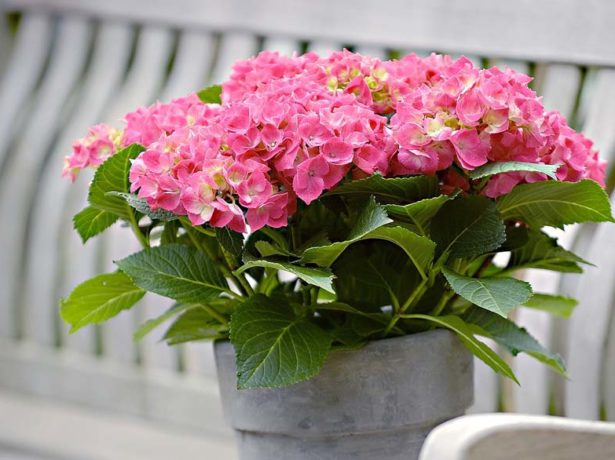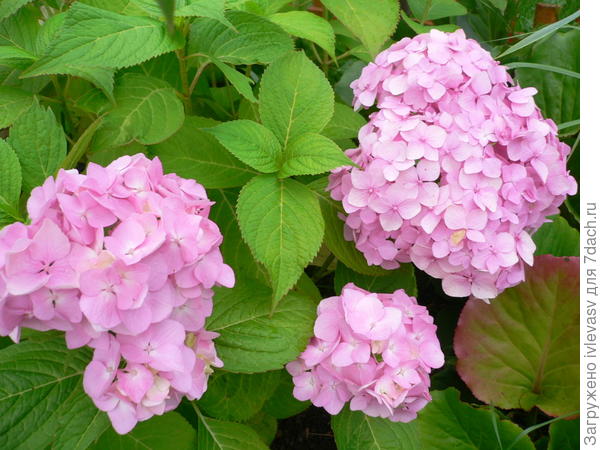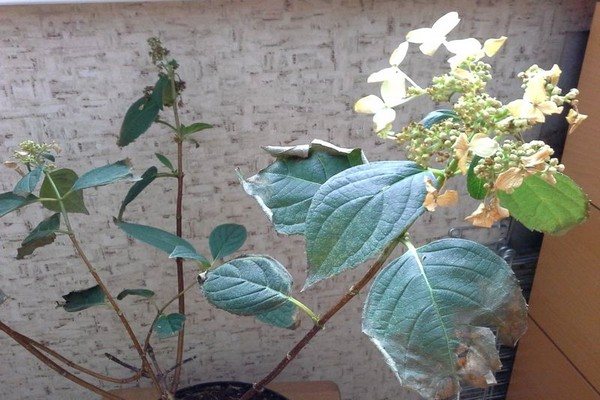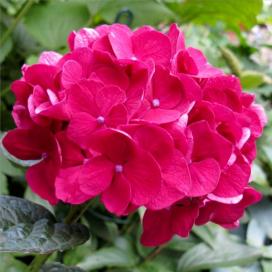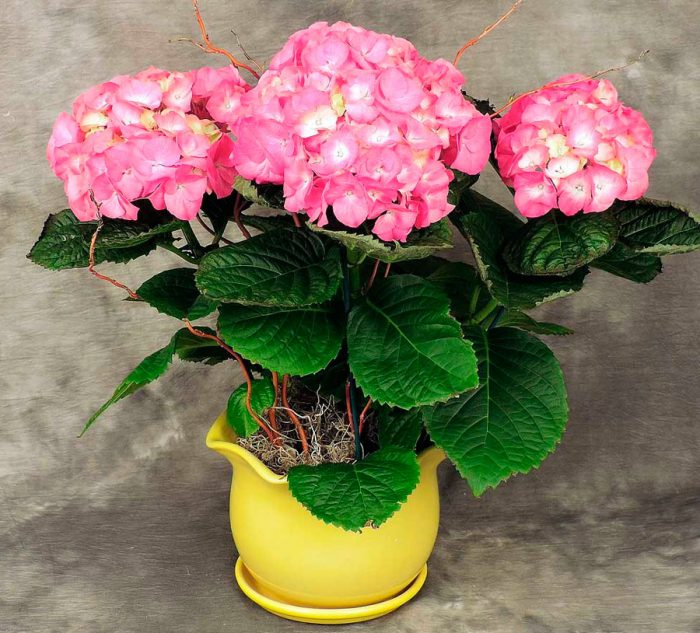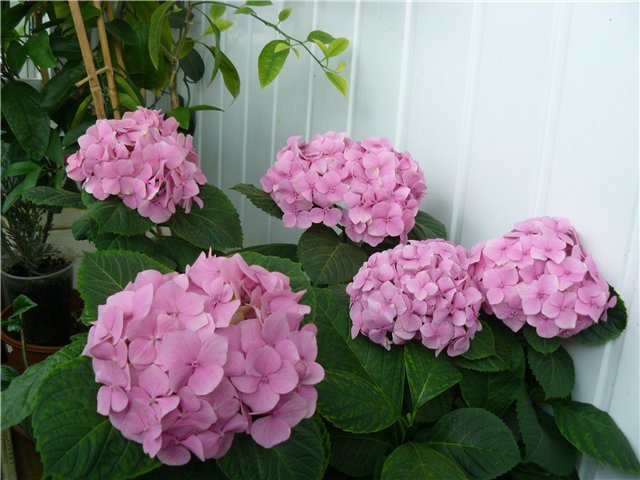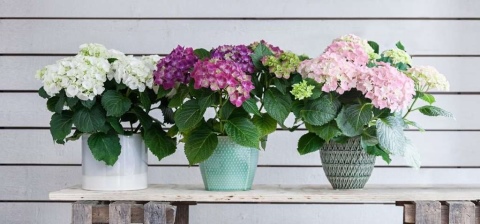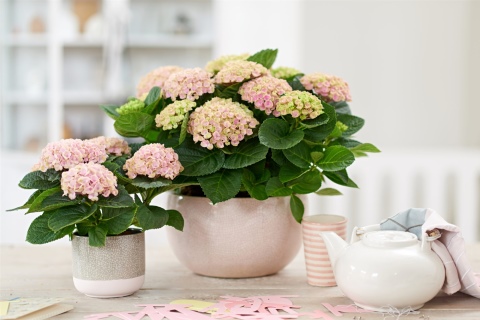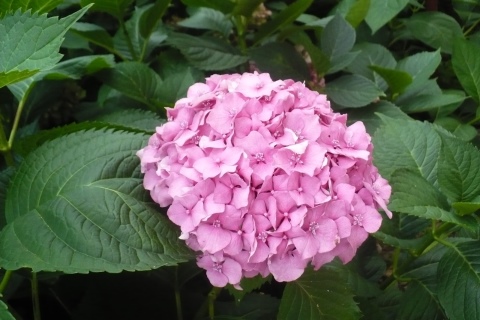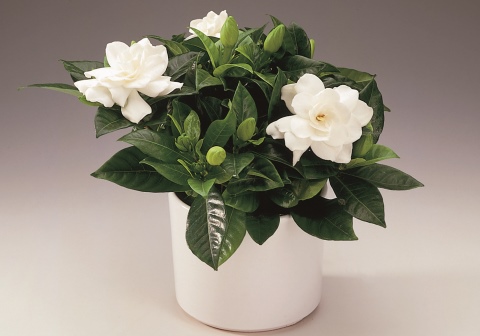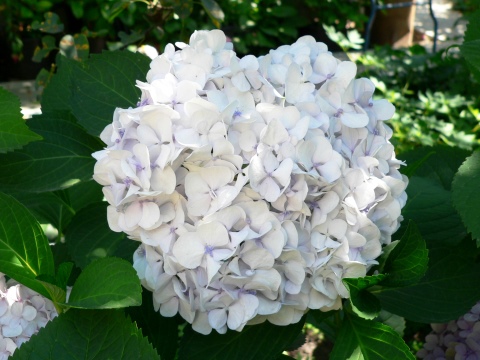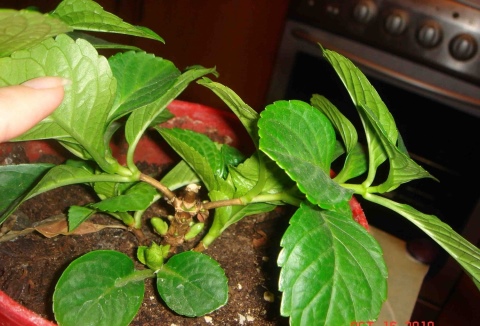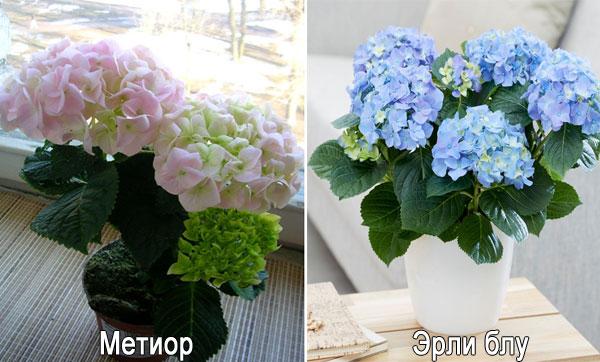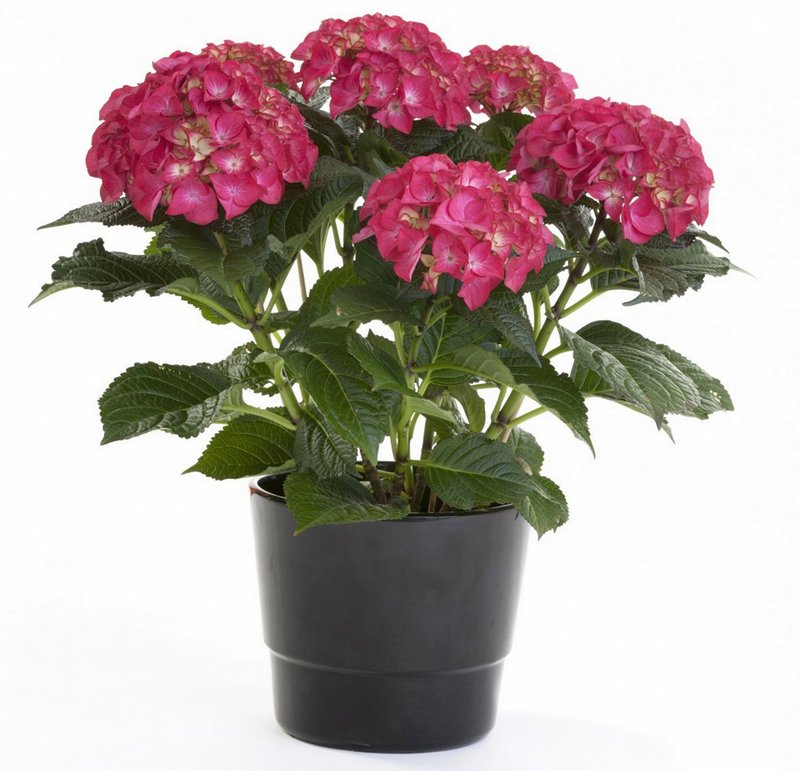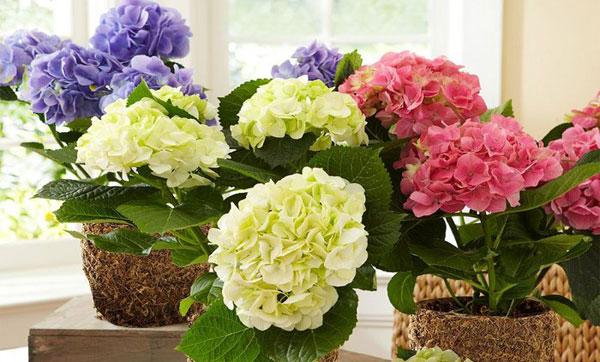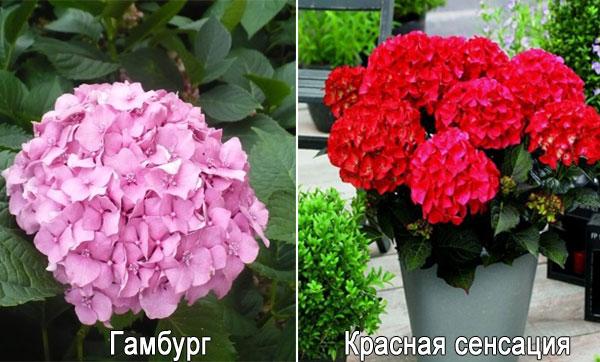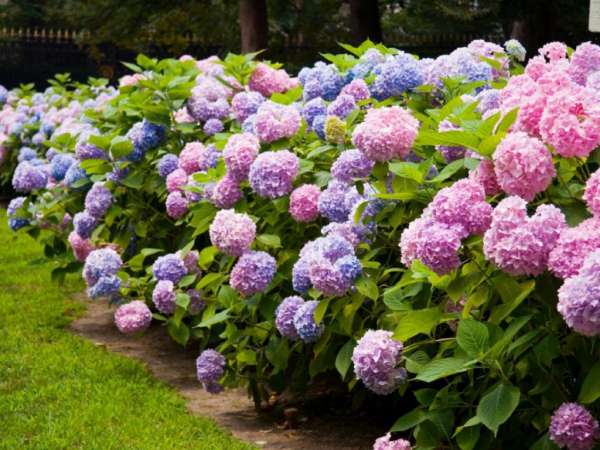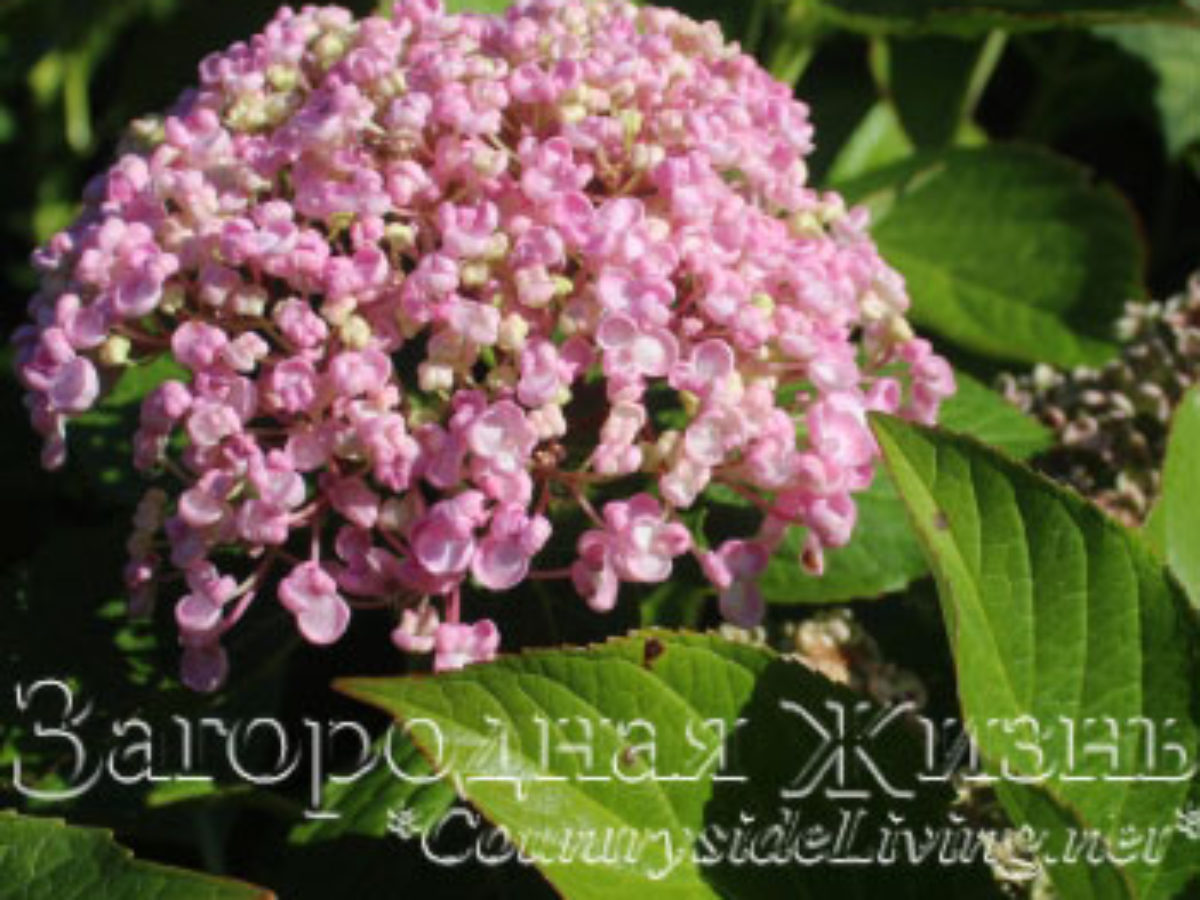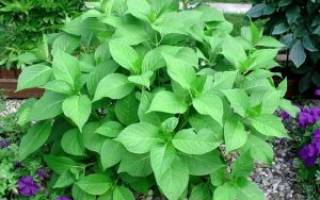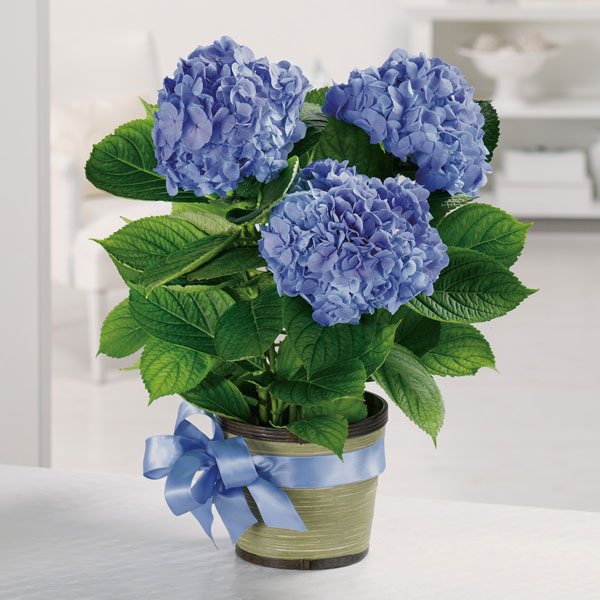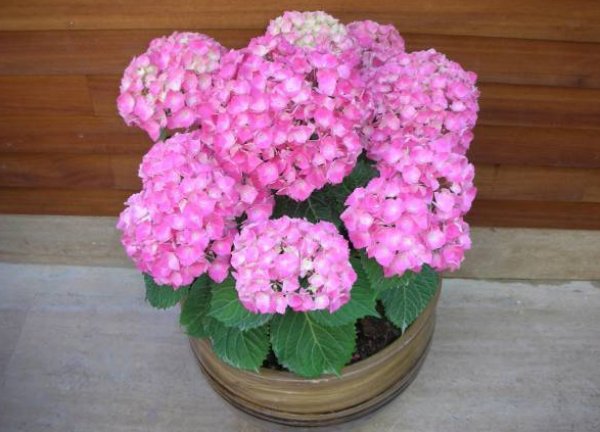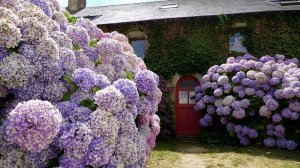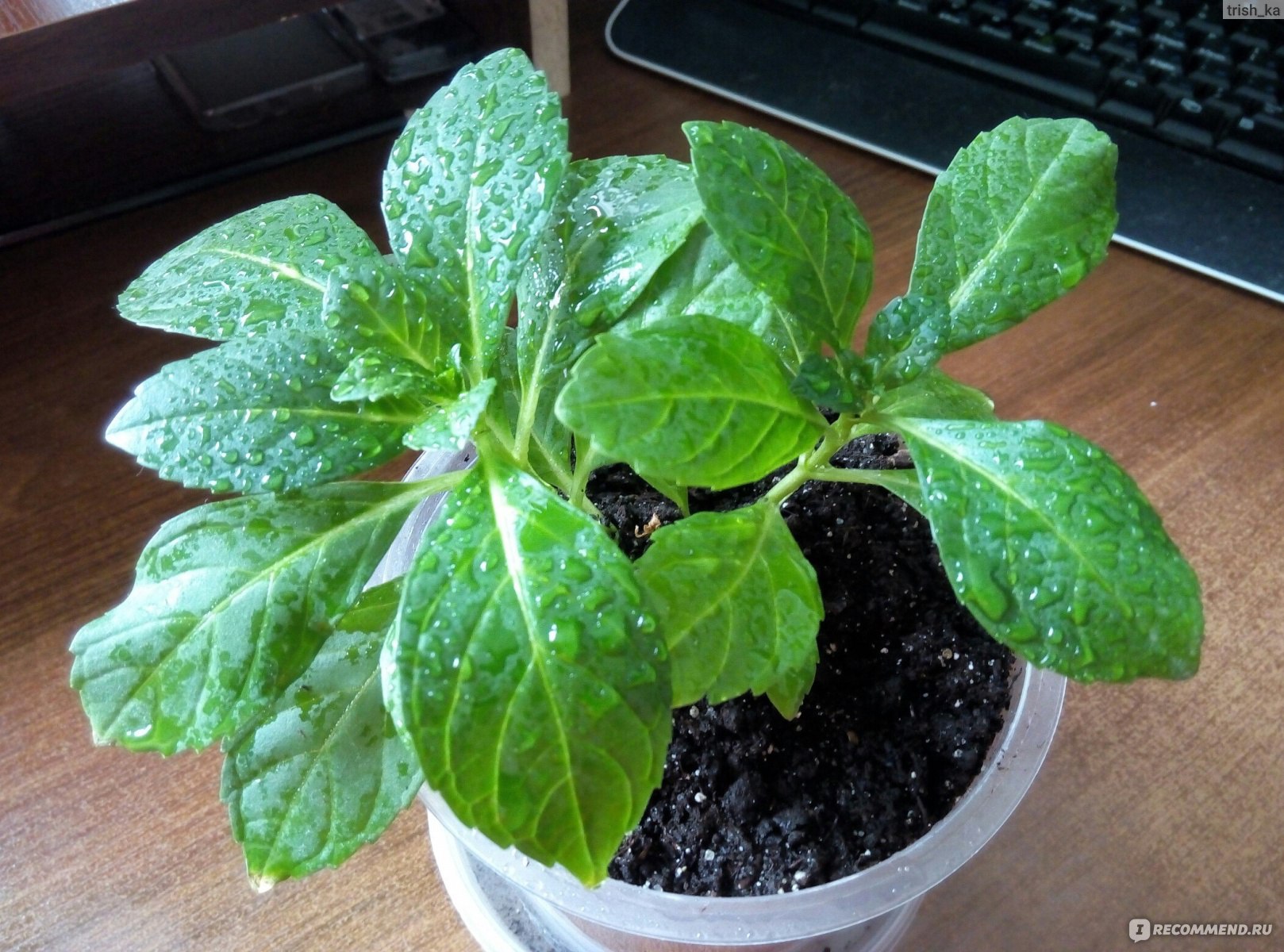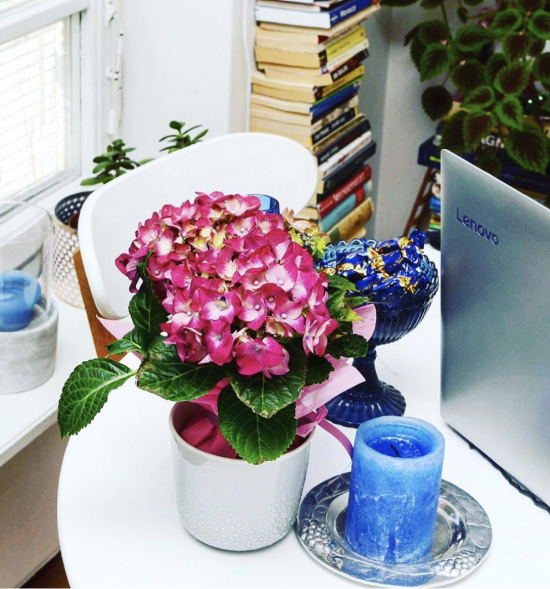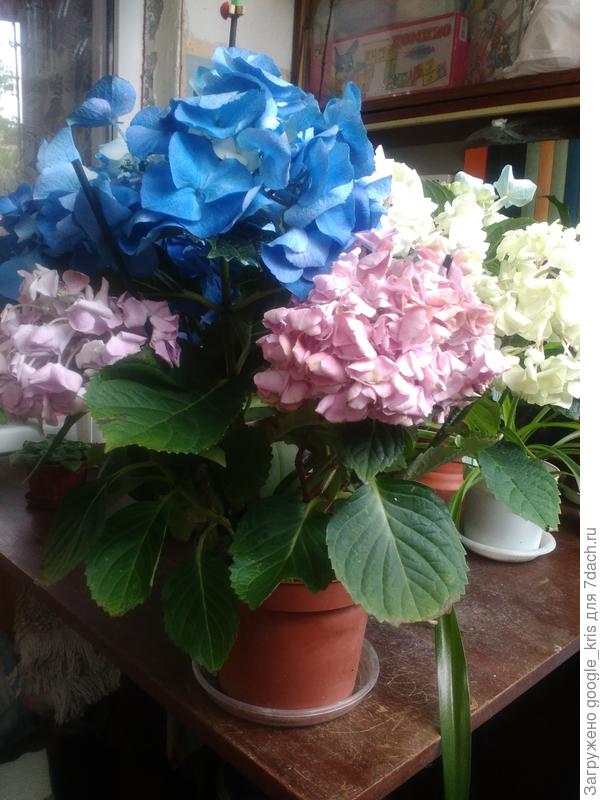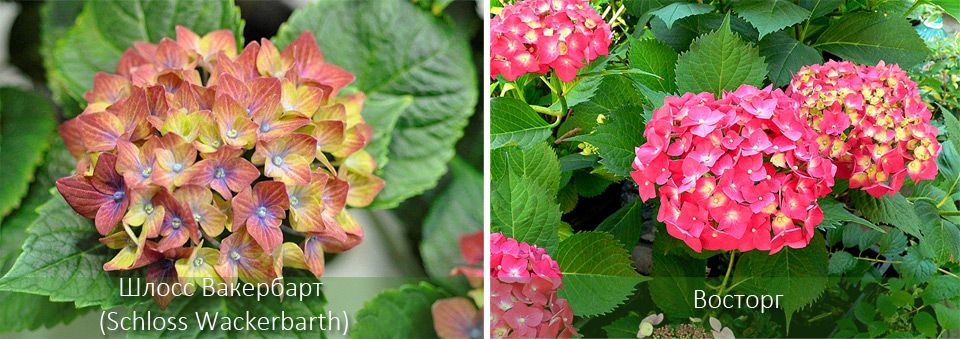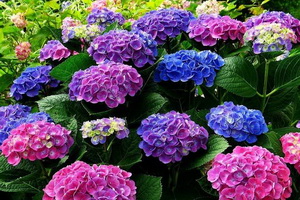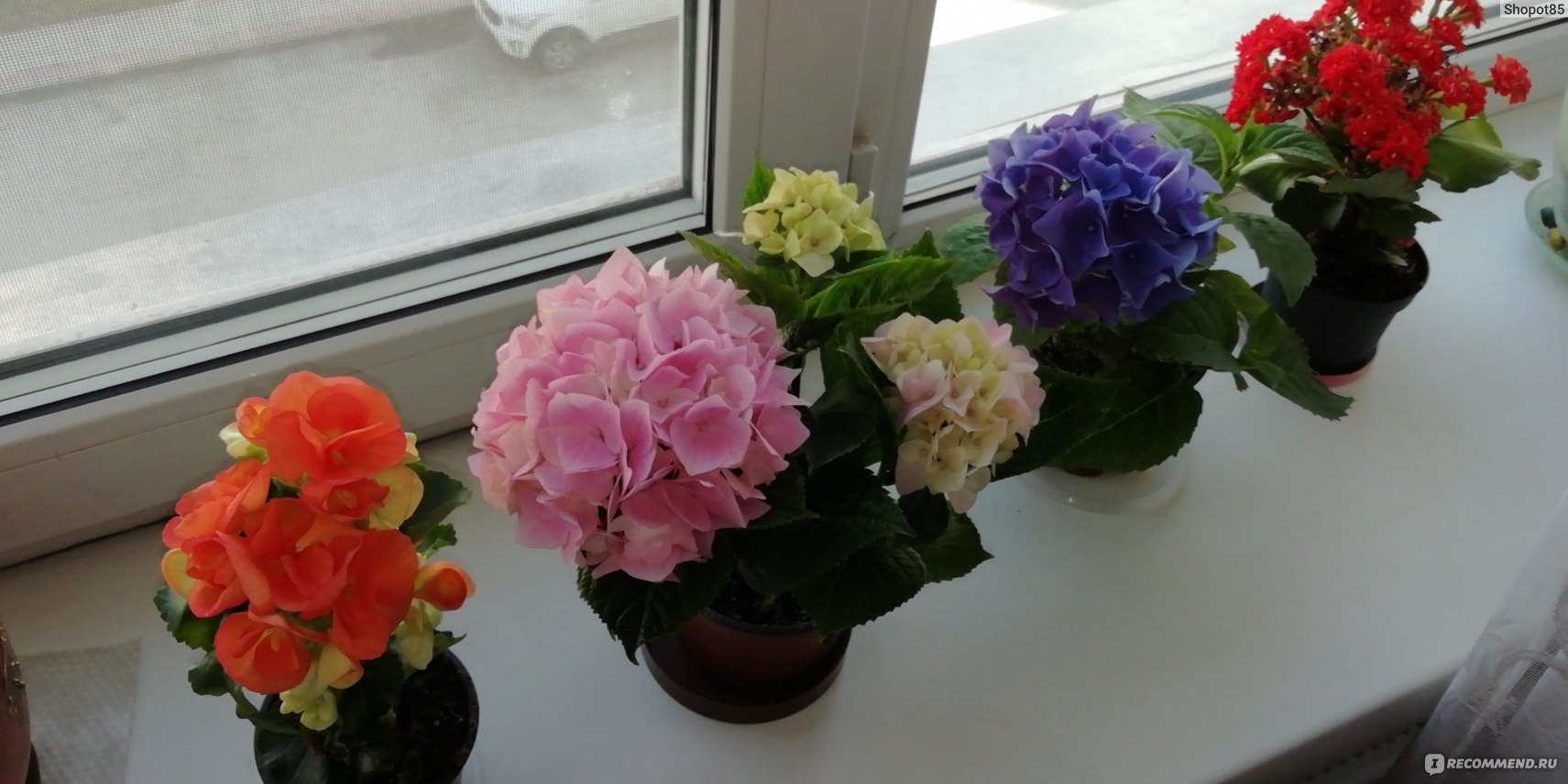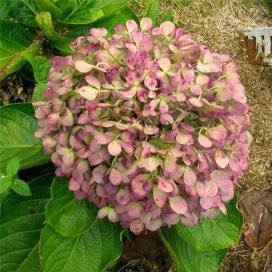Growing in a pot at home
Planting and transplanting
How to care for hydrangea at home? Plant indoor hydrangea in acidic soil with a pH of 5.5. The mixture can include peat, coniferous soil, humus and sand. The pot is preferable large and wide, due to the growing breadth of the root system. The root collar does not need to be covered; it should be at the same level with the ground. When planting, mulching with peat is recommended.
The hydrangea will have to be transplanted every 2-3 years. Each new pot should be 1.5 times the size of its predecessor.
Lighting
In summer, hydrangea prefers moderate sunshine, favorably accepts partial shade in a well-lit room. It is better to protect the flower from direct sunlight at this time. In winter, completely darkened rooms are also permissible - during the dormant period, lighting does not play a big role.
But at the end of winter, the plant will be happy with well-lit windowsills, because it needs a lot of light to form buds.
Watering
There is nothing outstanding about the hydrangea watering scheme. Experienced florists recommend not overdrying an earthen lump in a pot, but also not overmoistening it. Moderate to heavy watering is required as the topsoil dries up.
Reference! Surprisingly, the moisture-loving hydrangea is not afraid of overdrying, and there is always a good chance of "watering" the dried plant.
Water for irrigation should be soft, settled and reached room temperature. Some people prefer to water their hydrangeas with rain or cooled boiled water. In autumn, watering is reduced, and in winter, they stop altogether - until the buds appear.
Air humidity
Accustomed to the sea climate, hydrangea will be grateful for regular spraying, as it loves moisture. Especially often and abundantly spray a flower if it is located near heating devices that dry out the air (by the way, this is extremely undesirable for hydrangea).
It will not hurt hydrangeas and bathing: the flower pot is dipped in water for a while, and then the moisture is allowed to drain completely.
Temperature regime
During the active period, hydrangea requires temperatures in the range of 18-20 degrees Celsius. In the summer you can take it outside. During the rest period, the room should not be hotter than 8 degrees. Therefore, in winter, when exposing the flower to the windowsill, try to protect it from the heat of the batteries.
Fertilizer
Hydrangea is fed during its flowering once a week. Also, feeding is carried out in winter - to stimulate growth. For this, both complex mineral and organic fertilizers are suitable. Ammonium nitrate or superphosphate will help the flower grow.
Bloom
Hydrangea inflorescences have an impressive hemispherical shape, resembling an umbrella up to 20 cm in diameter. There can be up to 6 of them on one plant. They delight the eye of florists from April to November. The most spectacular flowers appear in hydrangeas in the early years of flowering. Over time, they decrease and can even bend due to the stretching of the shoots.
Recommendation! Why does indoor hydrangea not bloom? In order for the inflorescences to form as needed, you should regularly rejuvenate the plant - that is, engage in its vegetative propagation.
Do I need to trim?
After flowering, the shoots of the hydrangea are cut in half, leaving a few of the strongest. This will help the flower to form beautifully and harmoniously. Also, partial pruning is carried out in the spring - weak and overly elongated shoots are removed.
Reproduction methods
Indoor hydrangea is propagated by cuttings - as a rule, these are sprouts that make the crown too thick. The most suitable time for the breeding procedure is July. Shoots 7-10 cm long with 2-3 internodes are cut at an angle (3-4 m below the node).
The leaves are cut in half, after which the sprouts are planted in river sand or the lightest soil, deepening by 1.5-2 cm.They are either covered with a jar or polyethylene, or left open, but sprayed regularly.
The required temperature is 22-25 degrees Celsius. It is necessary to keep the cuttings in these conditions until the first leaves appear - as a rule, you have to wait up to one and a half months.
At this point, young hydrangeas can be planted in separate pots, after a couple of weeks, pinch the tops and gradually accustom them to normal conditions.
We watch a video about the reproduction of room hydrangea:
Growth per year
Growth rate of indoor hydrangea will depend on how you care for it. The maximum height that an indoor hydrangea can reach is 1 meter.
Description
Hydrangea is a prominent representative of the Hortensia family. In its natural environment, this perennial deciduous shrub is found in South and North America and the countries of East and South Asia.
At home, hydrangea reaches 1 meter in height. She has opposite large ovoid leaves, reaching 10-15 cm in length. The culture is distinguished by large buds - balls resembling caps. They reach up to 35 cm in diameter. The color of the petals depends on the type of soil: in an acidic environment, the buds acquire a blue tint, in a neutral soil, the caps become white or cream, and the alkaline earth makes them lilac or pink.
In Europe, this blooming beauty appeared in the 18th century. And she quickly won the love of gardeners. Since then, breeders have bred many varieties that amaze with their beauty and variety. The most popular varieties of large-leaved hydrangea for home cultivation are:
- Madame Emily Moulier. Dutch variety. The bush reaches a height of 120 cm and a width of 80 cm. It blooms from June to September. The buds are snow-white at first, but then acquire a pink tint.
- Goliath. The shrub reaches 60–70 cm in height. The plant has bright pink buds up to 30 cm in diameter.
- Earley blue. The shrub reaches 90 cm in height. It has densely collected rounded inflorescences up to 25 cm in diameter. The petals are painted in lilac-blue tones. Hydrangea of this variety blooms from early to late summer.
- Prima. Miniature variety with stems reaching 20-25 cm in length. The variety is distinguished by bright red buds with a diameter of 15-18 cm.
- Souer Tharese is a snow-white variety up to 40 cm high and with buds 15–17 cm in diameter.
- Ramars Mars is a compact bush with deep blue inflorescences. But to get this color, you will need to water the plant with aluminum sulfate. Otherwise, the inflorescences will remain pale pink. The diameter of the bud reaches 20 cm.The height of the plant is 90 cm.
Each of these varieties will adorn the florist's collection. But growing a homemade hydrangea in a pot is not easy. The beauty has a capricious character, and she pleases with buds only in a comfortable environment.
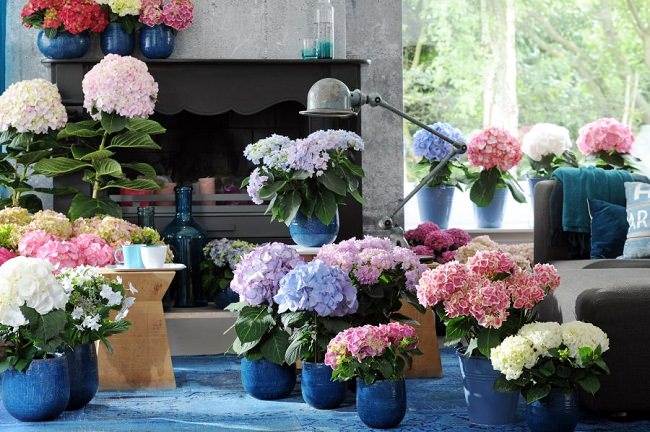
Transfer after purchase
You can transplant a hydrangea only after it has faded and has already been pruned annually. At this time, the plant prepares for a dormant period, stops its growth. If the plant was purchased in the fall, two weeks after the hydrangea appeared at home, it can be carefully transplanted into a permanent pot. She needs two weeks of rest to adapt to the new room, temperature and air movement.
What is needed for landing
The new pot should be 3-4 cm wider than the previous one. The roots of any sort of hydrangea develop more horizontally than in depth, so deep pots are not suitable for it.
It is necessary to increase the capacity every fall, allowing the root system to grow and nourish the plant during the period of active flowering.
Optimal location
To ensure abundant and regular flowering, the flower should stand in a sufficiently illuminated area, while not being exposed to direct sunlight. If the room where the hydrangea will live has east or west windows, it should be placed not on the windowsill, but near the window, on the outside of the tulle. So she will receive enough light, and her leaves will not suffer from the aggressive sun.
On the north or south window, the indoor beauty can be placed without fear by the leaves directly on the windowsill.
Step-by-step planting process
The transplant should begin with the preparation of the earthen mixture. The composition of the soil should contain sand and peat, their total share should not exceed 1 part, in relation to sod land, which requires 2 parts. Be sure to put drainage on the bottom of the new pot. It is unacceptable to include humus in the composition of the substrate.
Step-by-step transplant process:
Prepare a pot lined with drainage.
Watering the soil with the plant still in the old pot will facilitate the transshipment process, preserving the earthen lump.
Turning over the flower pot, carefully remove it, holding it by the stems, and then immediately lower it into a new pot.
Fill the voids between the rhizome and the walls of the container with the substrate so that no air gaps remain.
At the end of the transplant, water abundantly.
Additional Information. Transplanting a hydrangea in spring can affect its flowering, for which the plant was bought. Having lost the biological rhythm, the hydrangea transplanted in spring will bloom only by next winter.
SIMILAR MATERIALS
Hydrangea is effective in both single and group plantings. The main thing is that the soil is rich and ...
2
Panicle hydrangea is one of the most popular and beloved crops by gardeners. We deliberately ...
3
Treelike hydrangea appeared in my garden unexpectedly - a neighbor gave me layering. After a couple ...
Benefits of container gardening
Stable decorative effect. For container clearance ...
3
We are used to planting summer pots in flowerpots, with them a veranda, patio or gazebo will certainly transform. But …
2
20
Once, on March 8, I was presented with a large-leaved hydrangea bush of extraordinary beauty with bright ...
Description of the plant
At the moment, breeders have bred more than 100 varieties with different colors and sizes of inflorescences, so you can choose a hydrangea for indoor growing according to several parameters:
color;
the size of the peduncles;
the height of the bush.
If species that do better in indoor conditions, since they are crossed with adapted plant specimens.
Home hydrangea is a lush green bush with several round or pyramidal inflorescences. The inflorescence is complex, consists of small flowers collected in a bunch.

The leaves are dark, ovoid, with pronounced veins and pointed tips. With well-organized care and feeding during the flowering period, most of the bush is occupied by inflorescences - about 2/3 of the total volume.
At home, in a pot, you can find indoor hydrangea of all colors - red, white, blue, as well as halftone colors and color combinations.
You can admire the hydrangea at home until the very frost. Garden species also bloom for a long time, but subject to competent feeding, in which the caps of the inflorescences retain an attractive appearance.

All indoor hydrangeas are deciduous. Before wintering, they shed their foliage, so watering, feeding during this period is not required, since the roots do not consume food.
Differences from garden varieties
Caring for a hydrangea at home in a pot differs little from growing garden varieties. In addition to size (street varieties are taller and wider), there is also such a quality as frost resistance.
Indoor hydrangea is the same garden hydrangea, only with reduced frost resistance.In middle latitudes, a thermophilic plant does not survive - it needs a greenhouse or a whole range of warming measures.
Most often, cone-shaped hydrangea inflorescences are garden varieties, but they can also be kept in a large pot on the veranda.
Hydrangea home care photo: the main nuances of the content
Hydrangea room care at home, which will be correct, will certainly thank you for your efforts with a long and exuberant flowering.
Temperature and lighting

When deciding on a location for it, it is important to choose one where the direct rays of the sun will not fall, but there will be an abundance of light. Ideal for hydrangea will be a distance of 2-3 meters from the window.
In this case, development will be normal, and light spots will not appear on the leaves.
As for the temperature, the main thing is to avoid its sharp fluctuations and protect the hydrangea from drafts. 19-22 ° C is exactly the indicator at which the flowers will feel as comfortable as possible. It is best to remove the hydrangea for wintering in a dark, cool room (up to 9 °), for example, in the cellar, and return it back to the room closer to February. Without such a decrease in temperature, the plant will bloom only next year.
Hydrangea indoor home care photo: watering and feeding
The second name of the flower, hydrangea (lit. "tub of water"), speaks of a great love for water. Hydrangea at home in the summer needs regular and generous watering, and in the off-season - more moderate. In winter, you need to especially carefully control the amount of moisture in the flowerpots in order to avoid rotting of the root system and the death of the plant.
Melt, rain or settled water is great for hydrangeas. Occasionally, you can add lemon juice to it (5-7 drops per liter). This will help prevent yellowing of the leaves. Systematic spraying and, of course, the remoteness of the flower pots themselves from heating devices will be salvation from their drying.
It is necessary to introduce organic and mineral fertilizing into the soil in the summer in order to accelerate the development and blooming time of hydrangeas. Spraying with gibberellin (0.1 g per 1 liter of liquid) is also excellent for such purposes. With the appearance of the first flowers, a weak solution of manganese can be added to the irrigation water, and in winter, fertilizers can be abandoned altogether.
Hydrangea indoor home care video
To get a better understanding, watch the video in which the candidate of biological sciences, Elya Mamedova, confirms that this unpretentious plant, even for beginners, can look impeccable and really excellent.
Caring for indoor hydrangeas
It is necessary to care for a hydrangea in a pot, as well as for a free relative in the garden, by ensuring complete isolation from drafts, otherwise the foliage will begin to wither, right up to the death of the plant, without the possibility of any resuscitation.
Watering mode
Watering any sort of hydrangea should be regular, preventing the soil from drying out. Water needs to be defended at room temperature. During the flowering period, watering should be monitored especially carefully.
In winter, moistening the soil is also necessary, because the roots, even during dormancy, should not dry out.
Top dressing
In the summer, hydrangea is in dire need of mineral fertilizers. Additionally, during watering, you can add a small amount of potassium permanganate, which will protect the roots from infection. Without fertilization, the plant may not go into the flowering stage and remain just a green shrub.
During flowering
Blooming hydrangea should not be transplanted in order not to disrupt the natural life cycle of the flower. The air temperature in the room where the blooming beauty lives must be kept within the range from + 18˚C to + 22˚C. These are indications that are comfortable for all grades.
During the rest period
When the hydrangea has retired, it must be moved to a place where the air does not warm up above +9 and does not cool below +5.If the flower is left on the windowsill for the whole winter at room temperature, it will not feel wintering and will no longer bloom in the new season. For apartments, a balcony or an unheated staircase can become a place where the pot will stand all winter with the benefit of future flowering.

Hydrangea does not bloom
Preparing for winter
Before wintering, all diseased or weak shoots are cut off, leaving no chance of infecting the entire plant as a whole, because treatment is a complex process and does not always end with a positive result. A cache-pot with a plant of any type and age is transferred to a cool place, where the shoots will not be blown by the wind and exposed to frost.

During the dormant period, hydrangea needs pruning of dead inflorescences.
Growing indoor varieties of hydrangea means putting joy and bright colors on the windowsill. Indoor hydrangea does not require complex care at home and is ready to amaze with its shades. Compliance with simple rules for the temperature regime and the frequency of irrigation will ensure lush flowering almost all summer and all autumn.

